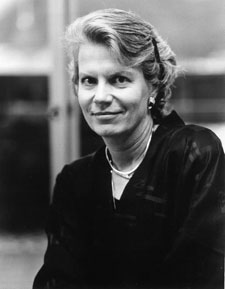7th Kaczmarczik Lecture
"SETI: Science Fact, Not Fiction"
Jill Tarter
Bernard M. Oliver Chair, SETI Institute
Thursday, November 14, 2001
3:30 p.m.
Main Building Auditorium
3141 Chestnut Street
Philadelphia, PA 19104
 Aliens abound on the movie screens, but in reality we are still trying to find out if we share our universe with other sentient creatures. Intelligence is very difficult to define, and impossible to directly detect over interstellar distances. Therefore, SETI, the search for extraterrestrial intelligence, is actually an attempt to detect evidence of another distant technology. If we find such evidence, we will infer the existence of intelligent technologists. For the past 40 years, the SETI community has had a very pragmatic definition of intelligence - the ability to build large transmitters! Almost all SETI searches to date have looked for radio signals coming from distant civilizations. This is not the only possible way to detect a technology across the vast distances that separate the stars. We've recently begun looking for very short optical pulses as well . As our own technology matures, we may try other means of searching, and we will certainly improve upon the searches that we are already conducting. Guiseppi Cocconi and Philip Morrison ended their 1959 seminal paper on SETI with the statement, "The probability of success is difficult to estimate; but if we never search, the chance of success is zero." This remains true today.
Aliens abound on the movie screens, but in reality we are still trying to find out if we share our universe with other sentient creatures. Intelligence is very difficult to define, and impossible to directly detect over interstellar distances. Therefore, SETI, the search for extraterrestrial intelligence, is actually an attempt to detect evidence of another distant technology. If we find such evidence, we will infer the existence of intelligent technologists. For the past 40 years, the SETI community has had a very pragmatic definition of intelligence - the ability to build large transmitters! Almost all SETI searches to date have looked for radio signals coming from distant civilizations. This is not the only possible way to detect a technology across the vast distances that separate the stars. We've recently begun looking for very short optical pulses as well . As our own technology matures, we may try other means of searching, and we will certainly improve upon the searches that we are already conducting. Guiseppi Cocconi and Philip Morrison ended their 1959 seminal paper on SETI with the statement, "The probability of success is difficult to estimate; but if we never search, the chance of success is zero." This remains true today.
Jill Tarter holds the Bernard M. Oliver Chair for SETI (Search for Extraterrestrial Intelligence) and heads the SETI Management Group for the SETI Institute in Mountain View, California. Tarter received her Bachelor of Engineering Physics Degree with Distinction from Cornell University and her Master's Degree and a Ph.D. in Astronomy from the University of California, Berkeley. She served as Project Scientist for NASA's SETI program, the High Resolution Microwave Survey (HRMS), and has conducted numerous observational programs at radio observatories worldwide. She has published scores of technical articles, has been elected to many professional societies, and has served on a number of scientific advisory committees. Tarter's work has brought her wide recognition in the scientific community, including the Lifetime Achievement Award from Women in Aerospace, two Public Service Medals from NASA, Chabot Observatory's Person of the Year award (1997), and a Women of Achievement Award in the Science and Technology category by the Women's Fund and the San Jose Mercury News (1998).
High School Open House Program:
12:30 - 1:00 p.m. Main Building Auditorium
1:00 - 3:00 p.m. Department of Physics Open House
Brief presentations on Biophysics, Astrophysics, Computational Physics, Condensed Matter, Nonlinear Dynamics, Particle Physics, etc. An excellent opportunity for high school students to visit our laboratories and meet in person with our internationally recognized researchers.
3:00 - 3:30 p.m. Reception
About the Kaczmarczik Lecture
Paul Kaczmarczik began his career as a Professor of Physics at Drexel University in 1953. A key player in building the Physics and Atmospheric Science Department, he made important contributions to teaching at Drexel University during his many years of service. Well-liked by both his colleagues and his students, Professor Kaczmarczik became Professor Emeritus in 1989. The Kaczmarczik Lecture Series was established in 1995 in honor of Professor Kaczmarczik. It brings to Drexel outstanding scientists to present lectures on topics at the cutting edge of Physics research.